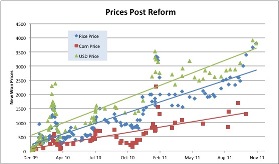Institute for Far Eastern Studies (IFES)
2013-4-25
After North Korea’s currency revaluation in 2009, North Korean currency is still unstable and North Korean markets near the DPRK-China border are reportedly filled with Chinese merchandise, with transactions being conducted mainly in Chinese yuan.
An online newspaper, the Daily NK, reported that markets in the city of Hyesan (Ryanggang Province) and surrounding areas are using Chinese yuan as the primary currency for transactions rather than local North Korean won. Rice prices are standard indicators of inflation in North Korea and even rice was reported to be exchanged in yuan. As the monetary value of domestic currency continues to fall, North Korea is experiencing hyperinflation and North Koreans are showing a preference for the more stable Chinese yuan over won.
With an exception of rice, vegetables, and seafood, manufactured goods including confectioneries, the daily necessities for sale in these markets are mostly from China. As well, some South Korean items such as instant noodles, Choco Pies, and butane gas are sold openly in the markets.
Border areas have a higher rate of Chinese yuan usage than inland areas, as for years traders have been buying Chinese goods with Chinese yuan to sell in the domestic markets. However, with the unstable domestic currency, more and more North Koreans have been using Chinese yuan over the last three years. Some report goods bought with North Korean won must be converted to the CNY exchange rate.
As of mid-April, the exchange rate of 100 CNY to KPW was 130,000. However, Pyongsong and Pyongyang cities used mainly US dollars and local won in equal rates.
A video recording obtained by the Daily NK unveiled the landscape of the marketplace and nearby alley markets of Hyesan and surrounding areas. Items for sale include jackets, mufflers, gloves, coats and other winter clothing as well as cosmetics, perfumes, toothpaste, toothbrushes and other daily goods. Transactions were being made in Chinese yuan.
North Korean authorities are waging a crackdown against the use of the yuan in the markets but merchants continue to use yuan in secret.
The high number of Chinese goods in North Korean markets can be attributed to the failed production system of the people’s economy of North Korea, which began to tumble in the late 1990s. As the regime began to invest excessively in its military sector, production in the manufacturing sector declined.
Although North Korean products appear in the markets, most people prefer Chinese goods due to their better quality.
A recent article in the official state economics journal of North Korea, Kyongje Yongu (Journal of Economic Research), criticized the “trade companies for focusing on only one or two countries,” expressing concerns that, “the whole nation may experience political and economic pressure from trade companies that restrict foreign trade to only one country.”
Kim Jong Un has also expressed official disapproval against “import syndrome” of the people and regarded it as an obstacle hindering the development of North Korea’s light industry.
Although no specific country was named, it is believed that China makes up over 80 percent of North Korea’s total foreign trade. North Korea continues to show vigilance against its rising dependence on China.

